The Australian Mounted Division originally formed as the Imperial Mounted Division in January 1917, was a mounted infantry, light horse and yeomanry division. The division was formed in Egypt, and along with the Anzac Mounted Division formed part of Desert Column, Egyptian Expeditionary Force in World War I. The division was originally made up of the Australian 3rd Light Horse Brigade, the reconstituted 4th Light Horse Brigade, and two British yeomanry brigades; the 5th Mounted Brigade and 6th Mounted Brigade.
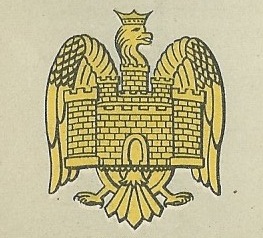
The Bedfordshire Yeomanry was a Yeomanry regiment of the British Army. Serving intermittently between 1797 and 1827, it was re-raised in 1901 for the Second Boer War. It participated in the First World War before being converted to an artillery regiment. It served in the Second World War. Its lineage was maintained by 201 Battery, 100th (Yeomanry) Regiment Royal Artillery until that unit was placed in suspended animation in 2014.
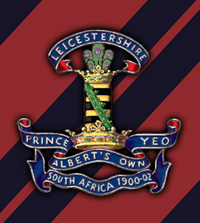
The Leicestershire Yeomanry (Prince Albert's Own) was a yeomanry regiment of the British Army, first raised in 1794 and again in 1803, which provided cavalry and mounted infantry in the Second Boer War and the First World War and provided two field artillery regiments of the Royal Artillery in the Second World War, before being amalgamated with the Derbyshire Yeomanry to form the Leicestershire and Derbyshire (Prince Albert's Own) Yeomanry in 1957. The regiment's lineage is currently perpetuated by E (Leicestershire and Derbyshire Yeomanry) Squadron of the Royal Yeomanry.
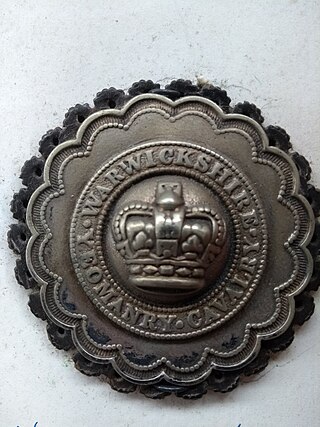
The Warwickshire Yeomanry was a yeomanry regiment of the British Army, first raised in 1794, which served as cavalry and machine gunners in the First World War and as a cavalry and an armoured regiment in the Second World War, before being amalgamated into the Queen's Own Warwickshire and Worcestershire Yeomanry in 1956. The lineage is maintained by B Squadron, part of The Royal Yeomanry.

The Lanarkshire Yeomanry was a yeomanry regiment of the British Army, first raised in 1819, which served as a dismounted infantry regiment in the First World War and provided two field artillery regiments in the Second World War, before being amalgamated into The Queen's Own Lowland Yeomanry in 1956. Its lineage was revived by B Squadron, the Scottish Yeomanry in 1992 until that unit was disbanded in 1999.
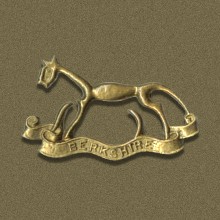
The Berkshire Yeomanry was a part time regiment of the British Army formed in 1794 to counter the threat of invasion during the French Revolutionary Wars. It was the Royal County of Berkshire's senior volunteer unit with over 200 years of voluntary military service. After taking part in the Second Boer War, it saw action as mounted troops in the First World War and as artillery in the Second World War. Its lineage is maintained by 94 Signal Squadron, part of 39 (Skinners) Signal Regiment. The Headquarters of the Squadron is based in Windsor, Berkshire. The Berkshire Yeomanry had a number of battle honours won from Europe to the Far East and Private Frederick Potts was awarded a Victoria Cross for service during the Gallipoli Campaign.
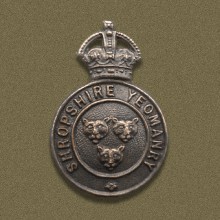
The Shropshire Yeomanry was a yeomanry regiment of the British Army, first raised in 1795, which served as a cavalry and dismounted infantry regiment in the First World War and as a cavalry and an artillery regiment in the Second World War. It was then amalgamated with the Shropshire Royal Horse Artillery.

The Duke of York's Own Loyal Suffolk Hussars was a Yeomanry regiment of the British Army. Originally formed as a volunteer cavalry force in 1793, it fought in the Second Boer war as part of the Imperial Yeomanry. In the World War I the regiment fought at Gallipoli, in Palestine and on the Western Front. The unit was subsequently converted into a Royal Artillery unit, serving in the anti-tank role North Africa, Italy and France during World War II. The lineage is maintained by No. 677 Squadron AAC.
The Denbighshire Hussars was a Welsh Yeomanry regiment of the British Army formed in 1794. It saw service in the First World War before being converted into a unit of the Royal Artillery. The lineage has been continued by 398 Squadron, Royal Logistic Corps.

The Lincolnshire Yeomanry was a volunteer cavalry unit of the British Army formed in 1794. It saw action in the Second Boer War and the First World War before being disbanded in 1920.
The Royal East Kent Yeomanry was a British Army regiment formed in 1794. It saw action in the Second Boer War and the First World War.

The Queen's Own West Kent Yeomanry was a British Army regiment formed in 1794. It served in the Second Boer War and the First World War. It amalgamated with the Royal East Kent Yeomanry to form the Kent Yeomanry in 1920.
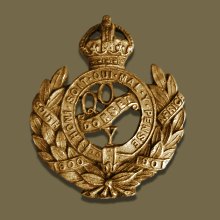
The Queen's Own Dorset Yeomanry was a yeomanry regiment of the British Army founded in 1794 as the Dorsetshire Regiment of Volunteer Yeomanry Cavalry in response to the growing threat of invasion during the Napoleonic wars. It gained its first royal association in 1833 as The Princess Victoria's Regiment of Dorset Yeomanry Cavalry, and its second, in 1843, as the Queen's Own Regiment of Dorset Yeomanry Cavalry.
The Welsh Horse Yeomanry was a yeomanry regiment of the British Army that served in the First World War. The regiment was raised shortly after the outbreak of the war. Initially it served in East Anglia on anti-invasion duties, before being dismounted in 1915 and sent to take part in the Gallipoli Campaign. After withdrawal to Egypt, it was amalgamated with the 1/1st Montgomeryshire Yeomanry as the 25th Battalion, Royal Welch Fusiliers and served as such throughout the rest of the war. It took part in the Sinai and Palestine Campaign in 1917 and 1918, before being transferred to the Western Front where it remained until the end of the war. The regiment formed 2nd and 3rd Lines in 1914, but these never left the United Kingdom before being disbanded in 1916 and early 1917, respectively. The 1st Line was disbanded in 1919.
The Royal North Devon Yeomanry was a Yeomanry regiment of the British Army. First raised in 1798, it participated in the Second Boer War and the First World War before being amalgamated with the Royal 1st Devon Yeomanry in 1920 to form the Royal Devon Yeomanry.

The 231st Brigade was an infantry brigade of the British Army that saw active service in both the First and the Second World Wars. In each case it was formed by redesignation of existing formations. In the First World War, it fought in Palestine and on the Western Front, while during the Second World War it served in the Allied invasion of Sicily, Italy and the Normandy landings of 6 June 1944.
The Royal 1st Devon Yeomanry was a Yeomanry regiment of the British Army. First raised in 1794, it participated in the Second Boer War and the First World War before being amalgamated with the Royal North Devon Yeomanry in 1920 to form the Royal Devon Yeomanry.
The Glamorganshire Royal Horse Artillery was a Territorial Force Royal Horse Artillery battery that was formed in Glamorganshire in 1908. It saw active service during the First World War on the Western Front in 1917 and 1918 as part of an Army Field Artillery Brigade. A second line battery, 2/1st Glamorganshire RHA, served in England and Ireland before being broken up in January 1917. Glamorganshire RHA was not reconstituted in the post-war Territorial Force.
The Shropshire Royal Horse Artillery was a Territorial Force Royal Horse Artillery battery that was formed in Shropshire in 1908 from the Shropshire Battery of the 1st Shropshire and Staffordshire Artillery Volunteers, Royal Garrison Artillery of the Volunteer Force. It saw active service during the First World War on the Western Front in 1917 and 1918 as part of an Army Field Artillery Brigade. A second line battery, 2/1st Shropshire RHA, also served on the Western Front in 1917 and 1918 as part of another Army Field Artillery Brigade. It was reconstituted post-war as a medium artillery battery and served as such in the Second World War.












